NIST的网络安全框架的重新审视
美国nist 网络安全

美国nist 网络安全NIST(National Institute of Standards and Technology,美国国家标准与技术研究所)是美国联邦政府机构,负责制定并推动各类标准、技术和创新。
在网络安全领域,NIST起到了重要的引领和指导作用。
本文将介绍NIST在网络安全方面的工作和贡献。
首先,NIST致力于制定各类网络安全标准和指南,帮助企业、政府机构和个人建立和提升网络安全防护能力。
NIST发布的网络安全框架(Cybersecurity Framework)是一个重要的指南,它提供了一套成熟和全面的网络安全管理方法,包括防御、检测、响应和恢复。
该框架能够促使组织建立有效的网络安全策略和流程。
此外,NIST还制定了一系列的网络安全标准,如FIPS (Federal Information Processing Standards)和NIST SP (Special Publication)系列。
FIPS标准规定了联邦政府机构和承包商在信息系统安全方面的要求,而NIST SP系列提供了各种网络安全方面的具体指南,包括密码学、身份认证、漏洞管理等。
NIST还通过其国家密码学与分布式数据安全中心(National Cryptographic and Distributed Data Security Center)在网络加密和密码学领域进行领先研究。
该中心通过与学术界和产业界的合作,推动密码学和分布式数据安全技术的发展和应用。
NIST还负责维护并发布美国政府的加密标准。
除了制定标准和指南,NIST还提供各种网络安全资源和工具,帮助组织和个人评估和改进网络安全措施。
NIST的网络安全评估程序(Security Assessment Procedure)可以帮助企业和政府机构评估其网络安全风险和脆弱性,根据评估结果采取相应的安全措施。
NIST还提供了一系列网络安全测量工具,如漏洞扫描工具和密码强度检查器,帮助用户发现和修复网络安全漏洞。
网络安全框架与标准解析
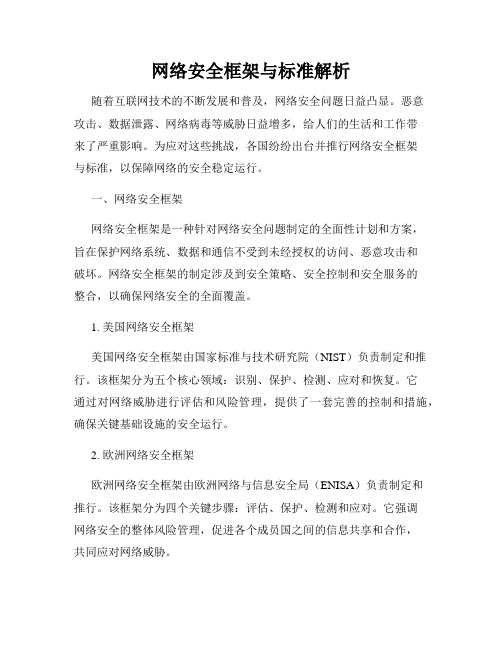
网络安全框架与标准解析随着互联网技术的不断发展和普及,网络安全问题日益凸显。
恶意攻击、数据泄露、网络病毒等威胁日益增多,给人们的生活和工作带来了严重影响。
为应对这些挑战,各国纷纷出台并推行网络安全框架与标准,以保障网络的安全稳定运行。
一、网络安全框架网络安全框架是一种针对网络安全问题制定的全面性计划和方案,旨在保护网络系统、数据和通信不受到未经授权的访问、恶意攻击和破坏。
网络安全框架的制定涉及到安全策略、安全控制和安全服务的整合,以确保网络安全的全面覆盖。
1. 美国网络安全框架美国网络安全框架由国家标准与技术研究院(NIST)负责制定和推行。
该框架分为五个核心领域:识别、保护、检测、应对和恢复。
它通过对网络威胁进行评估和风险管理,提供了一套完善的控制和措施,确保关键基础设施的安全运行。
2. 欧洲网络安全框架欧洲网络安全框架由欧洲网络与信息安全局(ENISA)负责制定和推行。
该框架分为四个关键步骤:评估、保护、检测和应对。
它强调网络安全的整体风险管理,促进各个成员国之间的信息共享和合作,共同应对网络威胁。
二、网络安全标准网络安全标准是对网络安全方面的技术和管理要求进行规范和规定,以确保网络安全措施的有效实施和运行。
网络安全标准的制定有助于提高网络系统和设备的安全性,减少网络攻击的发生和影响。
1. ISO/IEC 27001ISO/IEC 27001是国际标准化组织(ISO)和国际电工委员会(IEC)联合制定的信息安全管理体系标准。
它规定了信息安全管理的各个方面,包括安全政策、组织结构、资源管理、风险评估和控制等。
通过实施该标准,组织能够建立和维护有效的信息安全管理体系。
2. NIST SP800系列NIST SP800系列是美国国家标准与技术研究院(NIST)发布的一系列网络安全标准。
其中最为知名的是NIST SP800-53,它规定了联邦信息系统安全的技术和管理控制措施。
该标准被广泛应用于政府和企业的信息系统安全管理中。
美国网络安全框架

美国网络安全框架
美国网络安全框架(US Cybersecurity Framework)是由美国国家标准与技术研究所(NIST)提出并发布的一项指导性文件。
该框架旨在帮助公共和私人部门建立有效的网络安全措施,以减少网络威胁对国家和企业的风险和影响。
美国网络安全框架的设计基于九个关键功能领域,包括风险管理、安全控制和持续监控等。
该框架提供了一套灵活的指南和最佳实践,可以根据不同组织和行业的需求进行调整和定制。
首先,风险管理是框架的核心要素之一。
它强调了对网络和信息系统的潜在威胁进行评估,并采取相应措施来降低这些威胁的风险。
其次,安全控制是保护网络和信息系统的关键。
框架提供了一套安全控制措施,包括访问控制、身份验证和应急响应等,以防止未经授权的访问和数据泄露。
持续监控也是框架的重点之一。
它强调了对网络和信息系统的实时监测和检测,以及对异常活动的快速响应和恢复。
此外,框架还提供了培训和意识教育方面的建议,以提升组织内部员工对网络安全的认识和理解,并帮助他们采取正确的措施来保护敏感信息和数据。
美国网络安全框架不仅适用于大型企业和政府机构,也适用于中小企业和个人用户。
它为所有利益相关方提供了一个共同的
语言和方法,以提高网络安全的整体水平。
同时,框架还为组织提供了自我评估和改进的机会,以适应不断变化的网络威胁和技术环境。
总之,美国网络安全框架为组织提供了一个全面和系统的方法来应对网络安全威胁。
通过遵循框架的指南和建议,组织可以更好地防范网络攻击,保护重要的信息和资产,并及时恢复和响应任何安全事件。
NIST网络安全控制目录迎来新突破:去除“联邦”表述,不再仅限于“网络”

NIST网络安全控制目录迎来新突破:去除“联邦”表述,不再仅限于“网络”E安全8月20日讯美国国家标准与技术研究所(简称NIST)决定将“联邦”一词从其网络安全与隐私控制法规目录当中去除,而此项举措正是经历了长期拖延之后,最终于本周提出的一系列整改建议之一"络安全与隐私控制法规"最新修订NIST研究员罗恩·罗斯解释称,这是因为“目前包括美国联邦、各州以及地方政府与私营部门在内的各个方面都在使用同样的技术方案,而且也面临着同样的网络威胁。
”经过长达半年的漫长过程,NIST的研究人员们意识到这份控制目录除了对于美国联邦政府机构等传统“客户群体”极具意义以外,其它各方也可能同样从中获得重要的启发与指引。
因此,他们决定将这份名为《联邦信息系统与各组织安全与隐私控制》的目录(简称NIST SP-800-53)变更为《信息系统与各组织安全与隐私控制》,即删去“联邦”这一表述。
SP 800-53的上一次修订发生在2015年,不过最后一次完整重写则在2013年。
作为这份新草案的主要作者之一的罗斯在外媒采访当中表示,“目前还有其它一些对此抱有兴趣的社区可以自主利用本目录中提供的控制手段,并借此获得助益。
我们希望新草案能够受到各行业以及学术界内新受众的青睐”,甚至可以超越美国边界,因为这类资料“在全球范围内拥有大量受众群体。
”整合隐私控制罗斯同时指出,新目录还对所有变更进行了标记,其中包括将隐私控制整合至目录当中,这使其拥有了“独一无二”的比较优势。
“没有任何其它文件能够如此全面地将网络安全与隐私”整合至同一份指南当中。
罗斯认为,这一点在物联网技术蓬勃发展的背景之下显得尤为重要。
如果大家正在设计物联网设备或者智能家居,意味着其将把所有计算能力推向边缘网络。
从传统角度讲,边缘位置的安全性、保密性、完整性以及可访问性一直受到高度关注,而如今物联网与智能家居设备中驻留的个人数据同样需要隐私保护,二者可以相互加强。
美国国家标准与技术研究院(NIST)发布第二版《网络安全框架草案》

美国国家标准与技术研究院(NIST)发布第二版《网络安全
框架草案》
佚名
【期刊名称】《信息技术与网络安全》
【年(卷),期】2018(037)001
【摘要】美国国家标准与技术研究院(NIST)发布了NIST网络安全框架更新的第二稿。
NIST于2017年12月5日发布了”改进关键基础设施网络安全框架“(也就是网络安全框架1.1版草案2)提议更新的第二稿。
第二稿草案旨在澄清,改进和加强网络安全框架,扩大其价值并使其更易用。
新草案融入了收到的意见,这些意见来自2017年1月启动的公开审查流程和2017年5月的研讨会。
【总页数】1页(P2-2)
【正文语种】中文
【中图分类】TP393.08
【相关文献】
1.美国NIST发布网络安全框架第二稿 [J], ;
2.美国国家标准技术研究院(NIST) 发布森林火灾最新研究报告 [J],
3.美国国家标准技术研究院(NIST)召开网络会议-2020年NIST抗灾专题研讨会[J],
4.美国国家标准技术研究院(NIST)开展建筑间距对飞火积聚影响的研究 [J],
5.美国国家标准技术研究院(NIST)发表大型火灾试验量热测量技术改进研究成果[J],
因版权原因,仅展示原文概要,查看原文内容请购买。
nist csf最佳实践
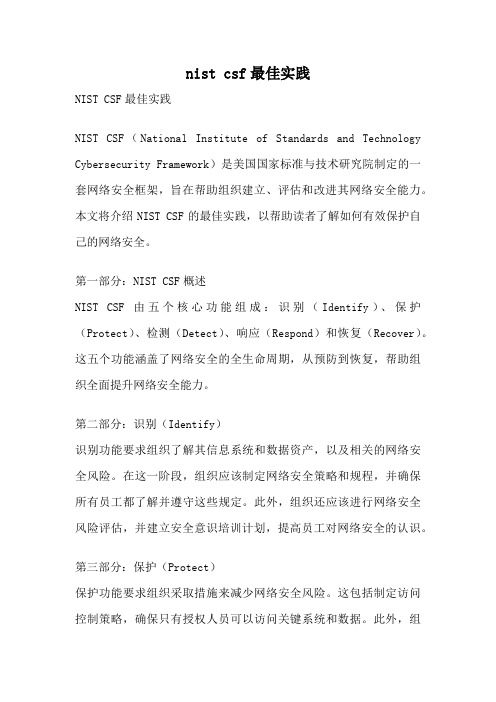
nist csf最佳实践NIST CSF最佳实践NIST CSF(National Institute of Standards and Technology Cybersecurity Framework)是美国国家标准与技术研究院制定的一套网络安全框架,旨在帮助组织建立、评估和改进其网络安全能力。
本文将介绍NIST CSF的最佳实践,以帮助读者了解如何有效保护自己的网络安全。
第一部分:NIST CSF概述NIST CSF由五个核心功能组成:识别(Identify)、保护(Protect)、检测(Detect)、响应(Respond)和恢复(Recover)。
这五个功能涵盖了网络安全的全生命周期,从预防到恢复,帮助组织全面提升网络安全能力。
第二部分:识别(Identify)识别功能要求组织了解其信息系统和数据资产,以及相关的网络安全风险。
在这一阶段,组织应该制定网络安全策略和规程,并确保所有员工都了解并遵守这些规定。
此外,组织还应该进行网络安全风险评估,并建立安全意识培训计划,提高员工对网络安全的认识。
第三部分:保护(Protect)保护功能要求组织采取措施来减少网络安全风险。
这包括制定访问控制策略,确保只有授权人员可以访问关键系统和数据。
此外,组织还应该实施身份验证和访问管理措施,以确保只有合法用户可以登录系统。
此外,组织还应该加密重要数据,并建立灾难恢复计划,以应对潜在的网络攻击和数据泄露。
第四部分:检测(Detect)检测功能要求组织能够及时发现网络安全事件和威胁。
为了实现这一目标,组织应该建立网络安全监控系统,定期检查系统日志和事件记录。
此外,组织还应该建立入侵检测系统和网络流量分析工具,以快速识别和响应网络攻击。
第五部分:响应(Respond)响应功能要求组织能够及时应对网络安全事件和威胁。
在发生安全事件后,组织应该立即启动应急响应计划,并与相关方面进行密切合作。
组织还应该进行溯源调查,确定安全事件的来源和影响范围,并采取适当的措施进行修复和恢复。
NIST关键基础设施网络安全改进框架介绍

NIST关键基础设施网络安全改进框架介绍作者:谢宗晓董坤祥张菡来源:《中国质量与标准导报》2017年第05期信息安全管理系列之二十八基于美国总统令EO 13636,NIST于2014年发布了《关键基础设施网络安全改进框架》,这个报告不但给出了网络空间安全管理的框架,而且与ISO/IEC 27001:2013等标准中具体的安全控制建立了映射关系。
由于目前国内尚没有相应的指导文件,因此下文中对其进行了简要的介绍。
谢宗晓(特约编辑)摘要:《关键基础设施网络安全改进框架》以风险管理为基础,建立了一个基于识别、保护、检测、响应和恢复为主要步骤的网络空间安全管理的框架。
论文对该报告从应用的角度进行了解读。
关键词:网络安全网络空间安全信息安全关键基础设施Introduction of NIST Framework for Improving Critical Infrastructure CybersecurityXie Zongxiao ( Business School, Nankai University )Dong Kunxiang ( School of Management Science and Engineering, Shandong University of Finance and Economics )Zhang Han ( Transportation Bureau of China Railway )Abstract: Based on risk management, Framework for Improving Critical Infrastructure Cybersecurity established a cyberspace security management framework, including Identity,Protect, Detect, Respond and Recover. This paper explains the report from the perspective of implementation.Key words: cybersecurity, cyberspace security, information security, critical infrastructure1 概述《关键基础设施网络安全改进框架》(Framework for Improving Critical Infrastructure Cybersecurity) 1)由NIST2)发布于2014年2月12日,主要是为了响应2013年2月12日奥巴马总统签署的总统令(Executive Order,EO)13636,标题为:Improving Critical Infrastructure Cybersecurity。
网络安全架构安全框架之综述

网络安全架构安全框架之综述这是一篇关于安全框架的集大成之作。
结合了9种具体框架进行了综述:ISO 27001、NIST CSF、ISO 27002、NIST SP 800-53、NIST SP 800-171、CIS 20、ISA/IEC 62443、COBIT 2019、ITIL。
安全框架为构建一致性安全能力提供了良好基础,但框架的多样性可能使其成为一个艰难的选择。
安全框架包含三类框架族:安全控制框架(SCF)、安全管理计划(SMP)框架、IT治理框架(ITGF)。
选择控制很重要,但正确地管理控制更重要。
一个管理不善的好控制,可能不如一个管理良好的坏控制。
这就是为什么说:安全管理计划(SMP)是最重要的框架。
安全框架与风险管理的关系:组织应采用基于风险的方法,来选择和管理各项安全控制措施。
RMF(风险管理框架)提供了决策过程,支持确定活动优先级、与业务沟通、证明费用和资源合理性。
最重要的是,它提供了一种持续评估业务活动、环境的方法。
所有安全框架,只有在与风险管理方法结合时,才能提供最佳结果。
安全框架与安全架构的关系:安全架构不是一个框架。
安全架构是一种为决策过程定义规则的方法,它使用安全框架来提供在给定用例中必须使用的安全控制组件。
对于没有安全架构功能的组织,安全框架提供了一种有价值的引导方法;对于具有安全架构功能的组织,安全框架也可以通过指示一组公共控制来加快将业务需求转换为控制标识的过程。
关于安全架构之综述,请参见《建立安全架构方法的指导框架》,以了解如何使用安全架构方法,从安全框架中获得最佳效果,并与风险管理相集成。
本报告译自Gartner于2020年非公开发布的《Security Frameworks: The What and Why, and How to Select Yours》。
译文近两万字,精简至一万言,稍作结构调整。
并无商业目的,只为同步信息。
如果存在侵权,联系笔者删除。
企业在NIST新的网络安全标准下或让面临更多的风险

企业在NIST新的网络安全标准下或让面临更多的风险美国国家标准与技术研究所(NIST)正在制定网络安全标准,如果无法满足这些标准,关键基础设施企业可能会面临新的责任风险。
企业网络安全需要新的技术手段,目前小草上网行为管理软路由正时刻关注企业网络安全新动态,倾力为企业解决各种网络难题。
这个NIST网络安全框架旨在为关键基础设施行业(例如电力、电信、金融服务和能源)的企业提供最佳安全做法。
该框架的制定还参考了行业利益相关者的意见。
该框架并不是强制执行特定的安全控制,而是提供广泛的标准来识别和保护关键数据、服务和资产。
它提供很多用来检测和响应攻击的最佳做法,缓解网络事件带来的影响以及风险。
奥巴马在2月份签发了行政命令,他表示需要迫切解决关键基础设施安全问题,抵御网络攻击。
政府官员称美国国会试图建立可行的网络安全立法,但屡遭失败。
参与该标准计划完全是自愿的。
行政命令要求负责关键部门的联邦机构通过激励以及其他方式来推动该标准的部署。
法律公司Venable LLP的律师Jason Wool表示,但在实践中,关键基础设施所有者和运营商将可能别无选择,他们必须遵循这些标准,或者至少展示他们部署了类似的安全措施。
忽视或者违反这些标准的企业可能面临诉讼以及其他责任索赔。
这些标准可能被视为关键基础设施行业安全措施的最低水平。
“你不需要采用这些标准,但事实上,这个框架列出了网络安全的建议做法,企业需要满足这些做法,”Wool表示,“在最低限度下,该框架要求关键基础设施的所有者和运营者了解自己的做法,并做出差距分析。
”即使企业不采用这些标准,他们也需要证明他们采取的做法是行之有效的。
Wool表示:“如果一家公司被起诉,该公司需要能够提供证据证明他们已经研读了这些标准,执行了风险评估,并以合理的方式管理他们的风险。
”Fox Rothschild公司的律师Scott Vernick表示,这个NIST标准最终可能成为特定领域的法规,由负责不同关键基础设施领域的联邦机构来监管。
美国网络空间安全体系(9):《提升关键基础设施网络安全框架》介绍
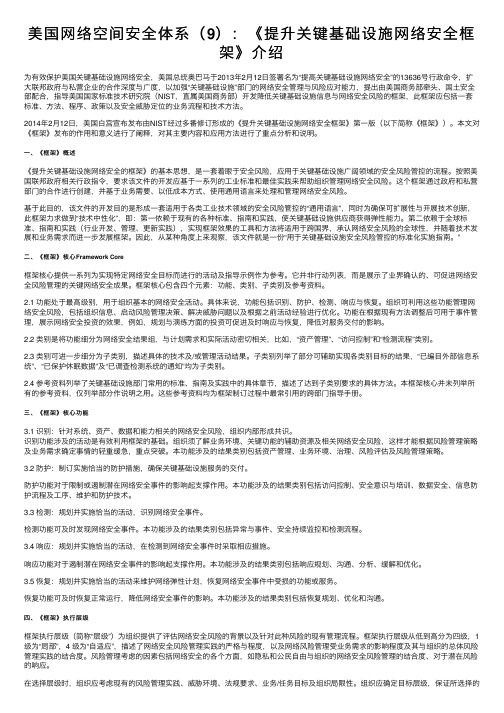
美国⽹络空间安全体系(9):《提升关键基础设施⽹络安全框架》介绍为有效保护美国关键基础设施⽹络安全,美国总统奥巴马于2013年2⽉12⽇签署名为“提⾼关键基础设施⽹络安全”的13636号⾏政命令,扩⼤联邦政府与私营企业的合作深度与⼴度,以加强“关键基础设施”部门的⽹络安全管理与风险应对能⼒,提出由美国商务部牵头、国⼟安全部配合,指导美国国家标准技术研究院(NIST,直属美国商务部)开发降低关键基础设施信息与⽹络安全风险的框架,此框架应包括⼀套标准、⽅法、程序、政策以及安全威胁定位的业务流程和技术⽅法。
2014年2⽉12⽇,美国⽩宫宣布发布由NIST经过多番修订形成的《提升关键基础设施⽹络安全框架》第⼀版(以下简称《框架》)。
本⽂对《框架》发布的作⽤和意义进⾏了阐释,对其主要内容和应⽤⽅法进⾏了重点分析和说明。
⼀、《框架》概述《提升关键基础设施⽹络安全的框架》的基本思想,是⼀套着眼于安全风险,应⽤于关键基础设施⼴阔领域的安全风险管控的流程。
按照美国联邦政府相关⾏政指令,要求该⽂件的开发应基于⼀系列的⼯业标准和最佳实践来帮助组织管理⽹络安全风险。
这个框架通过政府和私营部门的合作进⾏创建,并基于业务需要、以低成本⽅式、使⽤通⽤语⾔来处理和管理⽹络安全风险。
基于此⽬的,该⽂件的开发⽬的是形成⼀套适⽤于各类⼯业技术领域的安全风险管控的“通⽤语⾔”,同时为确保可扩展性与开展技术创新,此框架⼒求做到“技术中性化”,即:第⼀依赖于现有的各种标准、指南和实践,使关键基础设施供应商获得弹性能⼒。
第⼆依赖于全球标准、指南和实践(⾏业开发、管理、更新实践),实现框架效果的⼯具和⽅法将适⽤于跨国界,承认⽹络安全风险的全球性,并随着技术发展和业务需求⽽进⼀步发展框架。
因此,从某种⾓度上来观察,该⽂件就是⼀份“⽤于关键基础设施安全风险管控的标准化实施指南。
”⼆、《框架》核⼼Framework Core框架核⼼提供⼀系列为实现特定⽹络安全⽬标⽽进⾏的活动及指导⽰例作为参考。
美国联邦使用网络安全框架(CSF)的方法
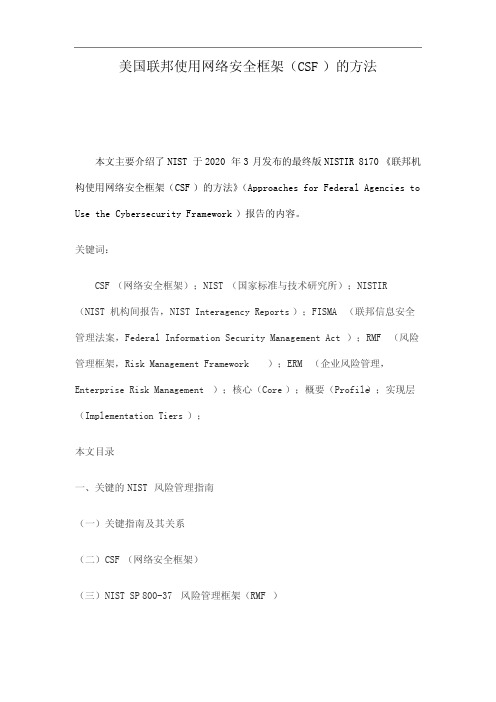
美国联邦使用网络安全框架(CSF)的方法
本文主要介绍了NIST于2020年3月发布的最终版NISTIR 8170《联邦机构使用网络安全框架(CSF)的方法》(Approaches for Federal Agencies to Use the Cybersecurity Framework)报告的内容。
关键词:
CSF(网络安全框架);NIST(国家标准与技术研究所);NISTIR
(NIST机构间报告,NIST Interagency Reports);FISMA(联邦信息安全管理法案,Federal Information Security Management Act);RMF(风险管理框架,Risk Management Framework);ERM(企业风险管理,Enterprise Risk Management);核心(Core);概要(Profile);实现层(Implementation Tiers);
本文目录
一、关键的NIST风险管理指南
(一)关键指南及其关系
(二)CSF(网络安全框架)
(三)NIST SP800-37风险管理框架(RMF)
(四)NIST SP800-39管理信息安全风险 (五)其它术语约定
二、联邦网络安全方法概述
三、联邦网络安全风险管理方法
(一)集成企业和网络安全风险管理 (二)管理网络安全需求
(三)整合并协调网络安全和采购流程 (四)评估组织网络安全
(五)管理网络安全计划
(六)维护对网络安全风险的全面了解 (七)报告网络安全风险
(八)为裁剪流程提供输入信息
一、基础背景与术语约定
(一)关键指南及其关系。
nist评估信息安全
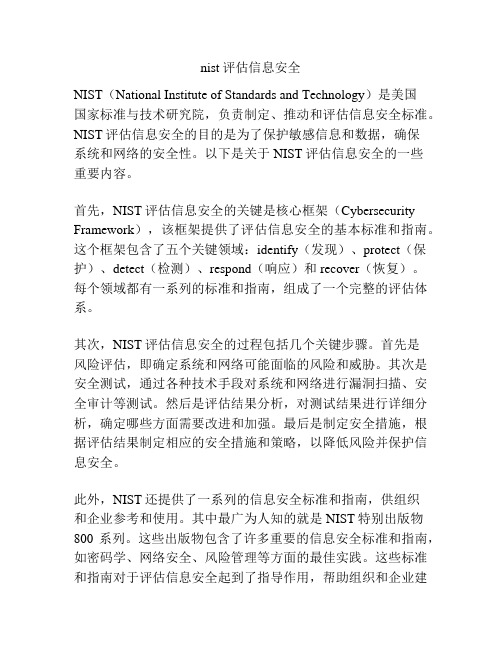
nist评估信息安全NIST(National Institute of Standards and Technology)是美国国家标准与技术研究院,负责制定、推动和评估信息安全标准。
NIST评估信息安全的目的是为了保护敏感信息和数据,确保系统和网络的安全性。
以下是关于NIST评估信息安全的一些重要内容。
首先,NIST评估信息安全的关键是核心框架(Cybersecurity Framework),该框架提供了评估信息安全的基本标准和指南。
这个框架包含了五个关键领域:identify(发现)、protect(保护)、detect(检测)、respond(响应)和recover(恢复)。
每个领域都有一系列的标准和指南,组成了一个完整的评估体系。
其次,NIST评估信息安全的过程包括几个关键步骤。
首先是风险评估,即确定系统和网络可能面临的风险和威胁。
其次是安全测试,通过各种技术手段对系统和网络进行漏洞扫描、安全审计等测试。
然后是评估结果分析,对测试结果进行详细分析,确定哪些方面需要改进和加强。
最后是制定安全措施,根据评估结果制定相应的安全措施和策略,以降低风险并保护信息安全。
此外,NIST还提供了一系列的信息安全标准和指南,供组织和企业参考和使用。
其中最广为人知的就是NIST特别出版物800系列。
这些出版物包含了许多重要的信息安全标准和指南,如密码学、网络安全、风险管理等方面的最佳实践。
这些标准和指南对于评估信息安全起到了指导作用,帮助组织和企业建立起健全的信息安全体系。
综上所述,NIST评估信息安全是一个基于核心框架、通过风险评估、安全测试和评估结果分析来制定安全措施的过程。
NIST提供了丰富的信息安全标准和指南,为组织和企业提供了实施和评估信息安全的重要参考。
这些工作的目的是确保信息安全,保护敏感信息和数据免受威胁和损害。
NIST网络安全标准和框架应用实践三大基本原则
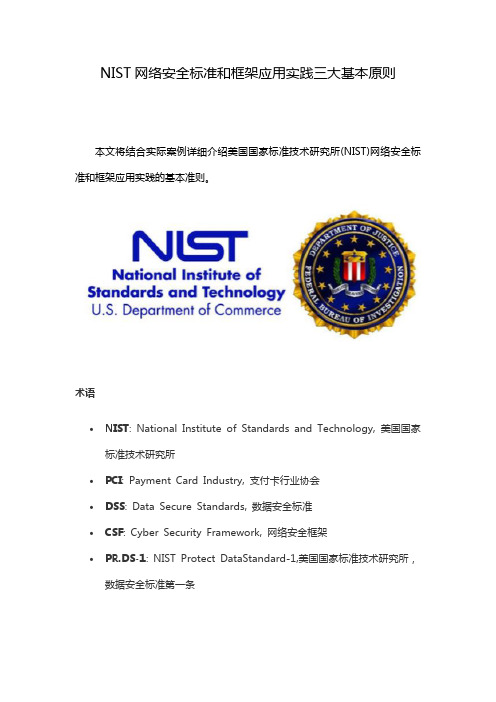
NIST网络安全标准和框架应用实践三大基本原则本文将结合实际案例详细介绍美国国家标准技术研究所(NIST)网络安全标准和框架应用实践的基本准则。
术语•NIST: National Institute of Standards and Technology, 美国国家标准技术研究所•PCI: Payment Card Industry, 支付卡行业协会•DSS: Data Secure Standards, 数据安全标准•CSF: Cyber Security Framework, 网络安全框架•PR.DS-1: NIST Protect DataStandard-1,美国国家标准技术研究所,数据安全标准第一条•SIEM: Security Information andEvent Management,安全信息和事件管理,计算机安全领域的子领域,其中软件产品和服务结合了安全信息管理(SIM)和安全事件管理(SEM)。
它们提供对由应用程序和网络硬件生成的安全警报的实时分析。
•EDR: Endpoint Detection andResponse, 端点检测和响应。
检测整个环境中的威胁,调查威胁的整个生命周期,提供所发生的安全事件跟踪信息,如它是如何进入的,它所处的位置,现在正在做什么以及如何阻止它的方案。
EDR解决方案通过在端点处包含威胁有助于消除威胁并防止其扩散。
•SOAR: Security Orchestration,Automation, and Response,SOAR 代表安全协调,自动化和响应。
Gartner将SOAR定义为“使组织能够收集由安全运营团队监视的输入的技术,SOAR工具使组织能够以数字工作流格式定义事件分析和响应过程。
”•DAT: DataAlignment Tool,数据对齐工具,数据对齐工具(DAT)旨在帮助分析在测试故障检测和诊断(faultdetection and diagnostics FDD)工具和调试构建(Cx)工具中使用的数据。
nist csf 实施方案

nist csf 实施方案NIST CSF 实施方案概述本方案旨在帮助组织实施NIST CSF(美国国家标准与技术研究院的网络安全框架)以提高其网络安全能力。
该方案将涵盖以下主要步骤和活动。
步骤1. 网络安全评估•进行组织内部及外部的网络安全评估,包括系统、设备和流程的安全性评估。
•评估当前的网络安全威胁和漏洞,并优先列出需要处理的风险。
2. 制定策略和目标•根据评估结果,制定明确的网络安全策略,并确定可量化的目标。
•确定关键的网络安全领域,并针对每个领域制定详细的目标和措施。
3. 实施控制和措施•根据NIST CSF的核心功能需求,制定针对性的控制和措施。
•确保控制和措施能够满足组织的网络安全策略和目标。
4. 监控和修复•建立网络安全事件的监控机制,及时检测和响应安全威胁。
•实施网络安全事件的修复措施,并进行后续的影响评估。
5. 整体改进•进行定期的网络安全性能评估,评估网络安全的成熟度。
•根据评估结果,持续改进网络安全策略和控制措施,提高组织的网络安全能力。
优势1.提供了一个基于NIST CSF的实施框架,可为组织提供全面的网络安全管理方案。
2.通过网络安全评估,帮助组织了解其网络安全现状,并提供了改进的建议。
3.制定具体的策略和目标,有助于提高组织的网络安全性能和应对能力。
4.实施控制和措施,能够降低组织面临的网络安全威胁和风险。
5.监控和修复措施的实施,能够提高组织对网络安全事件的感知和响应能力。
6.通过整体改进,组织可以不断提高其网络安全的成熟度和能力。
结论NIST CSF 实施方案是一个全面的网络安全管理方案,有助于组织提高其网络安全性能和保护能力。
通过明确的策略和目标、实施控制和措施、进行监控和修复,并持续进行整体改进,组织可以不断提高其网络安全能力,降低网络安全风险。
实施步骤详解1. 网络安全评估•进行组织内部及外部的网络安全评估,包括系统、设备和流程的安全性评估。
•评估当前的网络安全威胁和漏洞,并优先列出需要处理的风险。
美国网络安全等级保护
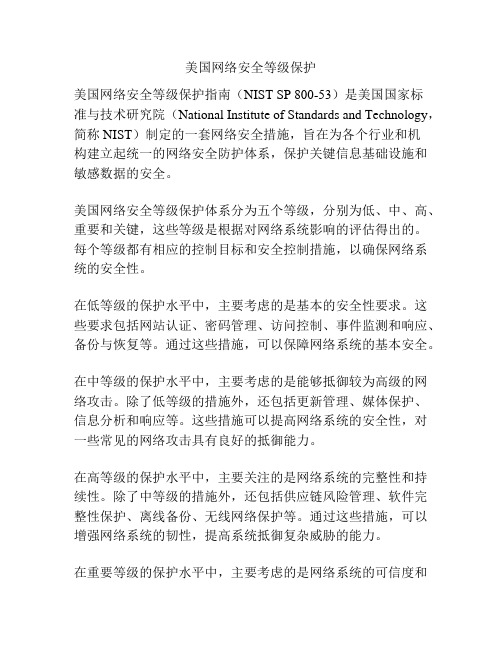
美国网络安全等级保护美国网络安全等级保护指南(NIST SP 800-53)是美国国家标准与技术研究院(National Institute of Standards and Technology,简称NIST)制定的一套网络安全措施,旨在为各个行业和机构建立起统一的网络安全防护体系,保护关键信息基础设施和敏感数据的安全。
美国网络安全等级保护体系分为五个等级,分别为低、中、高、重要和关键,这些等级是根据对网络系统影响的评估得出的。
每个等级都有相应的控制目标和安全控制措施,以确保网络系统的安全性。
在低等级的保护水平中,主要考虑的是基本的安全性要求。
这些要求包括网站认证、密码管理、访问控制、事件监测和响应、备份与恢复等。
通过这些措施,可以保障网络系统的基本安全。
在中等级的保护水平中,主要考虑的是能够抵御较为高级的网络攻击。
除了低等级的措施外,还包括更新管理、媒体保护、信息分析和响应等。
这些措施可以提高网络系统的安全性,对一些常见的网络攻击具有良好的抵御能力。
在高等级的保护水平中,主要关注的是网络系统的完整性和持续性。
除了中等级的措施外,还包括供应链风险管理、软件完整性保护、离线备份、无线网络保护等。
通过这些措施,可以增强网络系统的韧性,提高系统抵御复杂威胁的能力。
在重要等级的保护水平中,主要考虑的是网络系统的可信度和可靠性。
除了高等级的措施外,还包括安全操作、事件回应计划、安全测试和评估等,以加强网络系统的可信度和稳定性。
在关键等级的保护水平中,主要关注的是网络系统的绝对安全性。
除了重要等级的措施外,还需要实施更加严格的控制要求。
这些要求包括物理安全、数据分离、网络隔离等,以确保关键信息基础设施的安全。
总之,美国网络安全等级保护指南为各个行业和机构提供了一套统一的网络安全防护体系。
通过按照不同等级的要求实施相应的安全控制措施,可以保护关键信息基础设施和敏感数据的安全。
这些措施可以提高网络系统的安全性,抵御不同级别的网络攻击,并确保网络系统的可信度、可靠性和绝对安全性。
美国NIST《网络安全框架》中文版

(水平有限,翻译粗糙,仅供参考)为改善关键基础设施网络安全框架Version 1.0国家标准与技术研究所February 12, 2014Table of ContentsExecutive Summary (1)1.0 Framework Introduction (3)2.0 Framework Basics (7)3.0 How to Use the Framework (13)Appendix A: Framework Core (18)Appendix B: Glossary (37)Appendix C: Acronyms (39)List of FiguresFigure 1: Framework Core Structure (7)Figure 2: Notional Information and Decision Flows within an Organization (12)List of TablesTable 1: Function and Category Unique Identifiers (19)Table 2: Framework Core (20)执行摘要美国的国家安全和经济安全取决于关键基础设施的可靠运作的。
网络安全威胁攻击日益复杂和关键基础设施系统的连接,把国家的安全,经济,风险公众安全和健康。
类似的财务和声誉风险,网络安全风险影响到公司的底线。
它可以驱动多达费用及影响收入。
它可能会损害一个组织的创新,以获得并保持客户的能力。
为了更好地解决这些风险,总统于2013年2月12日,其中规定“[I] t是美国的政策,加强国家的安全和弹性颁布行政命令13636,”改善关键基础设施的网络安全。
“关键基础设施和维护,鼓励高效,创新,和经济繁荣,同时促进安全,保安,商业机密,隐私和公民自由。
“在制定这项政策的网络环境,执行命令为自愿风险的发展需要基于网络安全框架 - 一套行业标准和最佳实践,帮助企业管理网络安全风险。
NIST新版隐私框架:为内部审计量身定做的资源

In the 21st century, data is gold. It is what underpins some of the biggest companies in the world, including Amazon, Facebook, and Google. The need for gathering and using data has become a major economic driver, spawned a cybercriminal underworld, and pushed technological advancement to gather ever-increasing amounts of data, faster and more efficiently.在21世纪,数据就是黄金。
它支撑起了世界上的巨无霸公司,包括亚马逊、Facebook和谷歌。
对数据收集和利用的需求不仅演化成为主要的经济驱动力,而且也催生出网络犯罪的地下世界。
这些需求还推动了技术进步,实现更加快速、高效地收集不断增长的数据量。
过去20年,很多组织已经找到了收集和利用客户数据的信息技术方法,但只有很少组织花时间来关注这些数据的收集和利用是如何影响个人隐私的。
过去数年,政府一直致力控制个人数据资料的收集和牟利。
越来越多的、旨在规范个人数据的收集、管理、存储及保护等法律的出台,就反映了这种强烈的情绪。
欧盟的《一般数据保护条例》(General data protection Regulation,简称GDPR)颇具代表性。
上月末,美国商务部国家标准与技术研究院(NIST)发布了一个新的隐私保护框架。
它提供了一系列策略,以改进隐私保护实务,建立与客户的信任关系,遵守与日俱增的隐私保护法规。
这份以《通过企业风险管理改善隐私保护的工具》为副标题的隐私保护框架,与2014年NIST发布的《网络安全框架》相配套,为各类组织保护隐私实务提供指引。
网络安全框架与标准
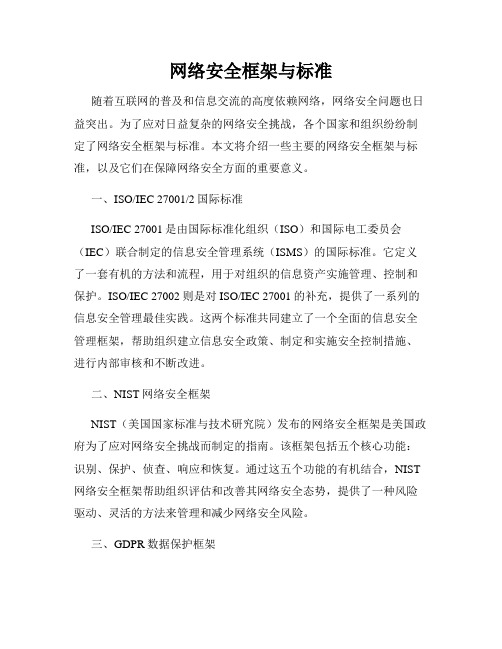
网络安全框架与标准随着互联网的普及和信息交流的高度依赖网络,网络安全问题也日益突出。
为了应对日益复杂的网络安全挑战,各个国家和组织纷纷制定了网络安全框架与标准。
本文将介绍一些主要的网络安全框架与标准,以及它们在保障网络安全方面的重要意义。
一、ISO/IEC 27001/2国际标准ISO/IEC 27001是由国际标准化组织(ISO)和国际电工委员会(IEC)联合制定的信息安全管理系统(ISMS)的国际标准。
它定义了一套有机的方法和流程,用于对组织的信息资产实施管理、控制和保护。
ISO/IEC 27002则是对ISO/IEC 27001的补充,提供了一系列的信息安全管理最佳实践。
这两个标准共同建立了一个全面的信息安全管理框架,帮助组织建立信息安全政策、制定和实施安全控制措施、进行内部审核和不断改进。
二、NIST网络安全框架NIST(美国国家标准与技术研究院)发布的网络安全框架是美国政府为了应对网络安全挑战而制定的指南。
该框架包括五个核心功能:识别、保护、侦查、响应和恢复。
通过这五个功能的有机结合,NIST 网络安全框架帮助组织评估和改善其网络安全态势,提供了一种风险驱动、灵活的方法来管理和减少网络安全风险。
三、GDPR数据保护框架GDPR(欧洲通用数据保护条例)是欧盟制定的一套数据保护法规。
GDPR的目标是保护个人数据的隐私和安全,对个人数据的处理和传输提出了严格的要求。
GDPR通过规定组织需要采取适当的技术和组织措施来保护个人数据的安全,促使组织在网络安全方面加强管理和保护。
四、PCI DSS支付卡行业数据安全标准PCI DSS(支付卡行业数据安全标准)是由五个国际支付卡品牌(Visa、MasterCard、American Express、Discover和JCB)共同制定的数据安全标准。
该标准适用于所有处理支付卡信息的组织,要求这些组织在保护支付卡持有人数据的过程中采取严格的安全措施。
PCI DSS为支付卡行业提供了一个共同的安全框架,促使组织加强支付卡数据的保护,防止数据泄露和滥用。
美国网络安全产业人才培养的标准化趋势——《网络安全人力框架》解析
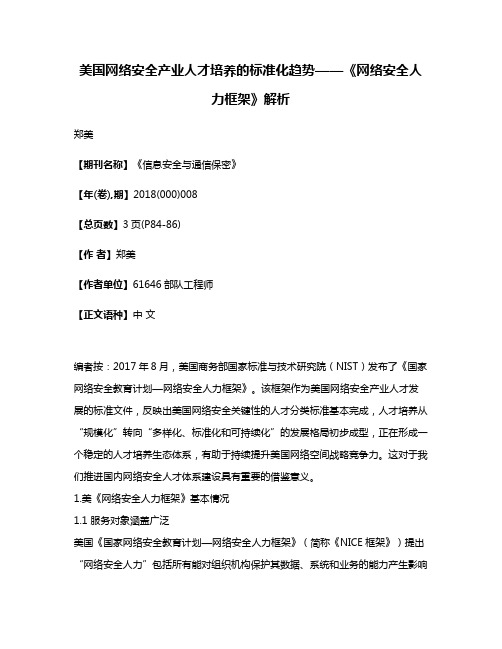
美国网络安全产业人才培养的标准化趋势——《网络安全人力框架》解析郑美【期刊名称】《信息安全与通信保密》【年(卷),期】2018(000)008【总页数】3页(P84-86)【作者】郑美【作者单位】61646部队工程师【正文语种】中文编者按:2017年8月,美国商务部国家标准与技术研究院(NIST)发布了《国家网络安全教育计划—网络安全人力框架》。
该框架作为美国网络安全产业人才发展的标准文件,反映出美国网络安全关键性的人才分类标准基本完成,人才培养从“规模化”转向“多样化、标准化和可持续化”的发展格局初步成型,正在形成一个稳定的人才培养生态体系,有助于持续提升美国网络空间战略竞争力。
这对于我们推进国内网络安全人才体系建设具有重要的借鉴意义。
1.美《网络安全人力框架》基本情况1.1 服务对象涵盖广泛美国《国家网络安全教育计划—网络安全人力框架》(简称《NICE框架》)提出“网络安全人力”包括所有能对组织机构保护其数据、系统和业务的能力产生影响的人员。
[3]从人员类别来看,该框架服务对象非常广泛,既包括从事网络安全的专业人员,也包括其他与网络安全相关的从业人员,如企业雇主、求职者、在岗工作人员、教育和培训人员以及技术供应商等。
《NICE框架》为社会上的各类组织机构和人员提供了一个统一的网络安全工作分类和描述的参考标准,所有参考《NICE框架》的用户能够根据自身需求灵活开展网络安全人才相关工作,将大幅提升网络安全人才甄别、招募、培训以及需求规划和发展的有效性。
1.2 标准结构专业细致《NICE框架》对网络安全人才的类别和能力标准进行了详细而专业的划分,以适应不同层次和不同岗位人员的需求。
整个框架标准结构由7个部分组成,即工作类别、专业领域、工作角色、任务以及所需的知识、技能和能力,它们之间的关系层层递进。
具体而言,框架定义了7种工作类别、33个专业领域、52个工作角色。
此外,NICE框架还列出了共1007项与工作角色相对应的“任务”、630项从事网络安全工作所需的“知识”、374项“技能”和176项“能力”。
- 1、下载文档前请自行甄别文档内容的完整性,平台不提供额外的编辑、内容补充、找答案等附加服务。
- 2、"仅部分预览"的文档,不可在线预览部分如存在完整性等问题,可反馈申请退款(可完整预览的文档不适用该条件!)。
- 3、如文档侵犯您的权益,请联系客服反馈,我们会尽快为您处理(人工客服工作时间:9:00-18:30)。
The NIST Cybersecurity Framework Revisited
By Torsten George on March 18, 2015
inShare124
Tweet
In February 2014 the National Institute of Standards and Technology (NIST) issued a new set of cyber security guidelines designed to help critical infrastructure providers better protect themselves against attacks.
The framework was the result of an executive order issued by President Barack Obama in 2013 to establish a set of voluntary cyber security standards for critical infrastructure companies. One year later, has the NIST Cybersecurity Framework had any measurable impact on improving cyber resilience or was it just smoke and mirrors as many opponents predicted at the time?
The NIST Cybersecurity Framework was born out of the realization that cyber-attacks represent one of the most serious economic and national security threats our nation faces. The framework offers:• A set of activities to anticipate and defend against cyber-attacks (the “Core”)
• A set of measurements to assess to what degree an organization has implemented the core activities and benchmark how prepared they are to protect systems against an attack (the “Im plementation Tiers”)
• A “Profile” that can be used to identify opportunities for improving an organization’s cyber security posture by comparing a current profile with a target profile.
In addition, the NIST Cybersecurity Framework includes a comprehensive collection of so-called Informative References, which are specific sections of standards, guidelines, and practices common among critical infrastructure sectors.
By assembling all these data points in a single repository, the government provided a common nomenclature and methodology to help less advanced organizations assess their level of security preparedness and benchmark themselves. In this regard, the NIST Cybersecurity Framework was a good first step towards creating a standardized approach to cyber security. However, it became immediately apparent at the time of its release that the framework required many substantial updates before it could really help improve the nation’s cyber resilience. It’s not surprising that, despite some anecdotal evidence presented to a Senate committee
at a February 4th hearing, there has been no measurable proof that using the framework can help prevent cyber-attacks.
Ultimately, the NIST Cybersecurity Framework provides some valuable building blocks for implementing better cyber security practices, but is not a silver bullet for preventing cyber-attacks and data breaches. It’s important to understand that guidelines and regulations are static by nature and therefore cannot evolve to detect and mitigate morphing threats. Meanwhile, regulatory compliance moves far too slowly to keep up with cyber-attackers. Guidelines can also expose holes in proposed measures, which attackers can use as a blueprint for their attack strategy. Ultimately, proper security measures and best practices are just one part of the solution. One of the biggest challenges for organizations is managing the sheer volume, velocity, and complexity of data feeds that must be analyzed, normalized, and prioritized to even stand a chance of detecting a cyber-attack. The Target breach was a good example. Although the best-of-breed technology in place was able to detect the intrusion early on, the alerts were buried in a sea of data which prevented the security team from connecting the dots and responding in a timely fashion. Instead, a third-party reported
the stolen data being posted on the Internet and exposed the breach.
Without data automation it can take months and even years to perform big data risk analysis and piece together an actionable security assessment. Findings ways to use technology to overcome the lack of human resources needed to extract intelligence from security feeds and respond in a timely fashion should remain a focal point for organizations.
In this context, the NIST Cybersecurity Framework is an important building block, but still just the first step towards implementing operationalized defenses against cyber security risks.
Related: NIST Releases Cyber Security Framework for Critical Industries。
